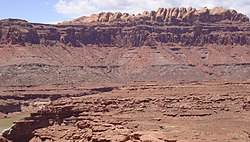Relative dating

Relative dating is the science of determining the relative order of past events (i.e., the age of an object in comparison to another), without necessarily determining their
Geology
The regular order of the occurrence of fossils in rock layers was discovered around 1800 by
Principles of relative dating
Methods for relative dating were developed when geology first emerged as a natural science in the 18th century. Geologists still use the following principles today as a means to provide information about geologic history and the timing of geologic events.
Uniformitarianism
The
Intrusive relationships
The principle of
Cross-cutting relationships
The
Inclusions and components
The
Original horizontality
The principle of original horizontality states that the deposition of sediments occurs as essentially horizontal beds. Observation of modern marine and non-marine sediments in a wide variety of environments supports this generalization (although cross-bedding is inclined, the overall orientation of cross-bedded units is horizontal).[4]
Superposition
The law of superposition states that a sedimentary rock layer in a tectonically undisturbed sequence is younger than the one beneath it and older than the one above it. This is because it is not possible for a younger layer to slip beneath a layer previously deposited. The only disturbance that the layers experience is bioturbation, in which animals and/or plants move things in the layers. however, this process is not enough to allow the layers to change their positions. This principle allows sedimentary layers to be viewed as a form of vertical time line, a partial or complete record of the time elapsed from deposition of the lowest layer to deposition of the highest bed.[4]
Faunal succession
The
Lateral continuity

The principle of lateral continuity states that layers of sediment initially extend laterally in all directions; in other words, they are laterally continuous. As a result, rocks that are otherwise similar, but are now separated by a valley or other erosional feature, can be assumed to be originally continuous.
Layers of sediment do not extend indefinitely; rather, the limits can be recognized and are controlled by the amount and type of sediment available and the size and shape of the sedimentary basin. Sediment will continue to be transported to an area and it will eventually be deposited. However, the layer of that material will become thinner as the amount of material lessens away from the source.
Often, coarser-grained material can no longer be transported to an area because the transporting medium has insufficient energy to carry it to that location. In its place, the particles that settle from the transporting medium will be finer-grained, and there will be a lateral transition from coarser- to finer-grained material. The lateral variation in sediment within a
If sufficient sedimentary material is available, it will be deposited up to the limits of the sedimentary basin. Often, the sedimentary basin is within rocks that are very different from the sediments that are being deposited, in which the lateral limits of the sedimentary layer will be marked by an abrupt change in rock type.
Inclusions of igneous rocks

Sorby (1858) was the first to document microscopic melt inclusions in crystals. The study of melt inclusions has been driven more recently by the development of sophisticated chemical analysis techniques. Scientists from the former Soviet Union lead the study of melt inclusions in the decades after World War II (Sobolev and Kostyuk, 1975), and developed methods for heating melt inclusions under a microscope, so changes could be directly observed.
Although they are small, melt inclusions may contain a number of different constituents, including glass (which represents magma that has been quenched by rapid cooling), small crystals and a separate vapour-rich bubble. They occur in most of the crystals found in igneous rocks and are common in the minerals
Included fragments
The
This is a restatement of
Planetology
Relative dating is used to determine the order of events on
Craters are very useful in relative dating; as a general rule, the younger a planetary surface is, the fewer craters it has. If long-term cratering rates are known to enough precision, crude absolute dates can be applied based on craters alone; however, cratering rates outside the Earth-Moon system are poorly known.[8]
Archaeology
Relative dating methods in archaeology are similar to some of those applied in geology. The principles of typology can be compared to the biostratigraphic approach in geology.
See also
- Astronomical chronology
- Age of the Earth
- Age of the universe
- Chronological dating, archaeological chronology
- Absolute dating
- Relative dating, this article
- Phase (archaeology)
- Archaeological association
- Archaeological context
- Archaeological culture – Group of artifact types and structure layouts that often occur together
- Relationship (archaeology) – relationship in space and time between archaeological objects or contexts
- Sequence
- Seriation (archaeology) – Archaeological method of relative dating
- Geologic time scale
- Geological history of Earth
- Future of the Earth
- Geologic time scale
- General
- Consilience, evidence from independent, unrelated sources can "converge" on strong conclusions
References
- ISBN 0-7167-2882-6.
- EJ Brill, 1963.
- ISBN 978-0-470-38774-0.
- ^ a b c Olsen, Paul E. (2001). "Steno's Principles of Stratigraphy". Dinosaurs and the History of Life. Columbia University. Archived from the original on 2008-05-09. Retrieved 2009-03-14.
- ^ As recounted in Simon Winchester, The Map that Changed the World (New York: HarperCollins, 2001), pp. 59–91.
- ^ See "Reading Rocks by Wesleyan University" Archived 2011-05-14 at the Wayback Machine retrieved May 8, 2011
- ISBN 978-0-435-69211-7
- ISBN 0-534-54630-7.
Citations
- "Biostratigraphy: William Smith". Understanding Evolution. 2009. University of California Museum of Paleontology. 23 January 2009 <http://evolution.berkeley.edu/evolibrary/article/0_0_0/history_11>
- Monroe, James S., and Reed Wicander. The Changing Earth: Exploring Geology and Evolution, 2nd ed. Belmont: West Publishing Company, 1997. ISBN 0-314-09577-2
